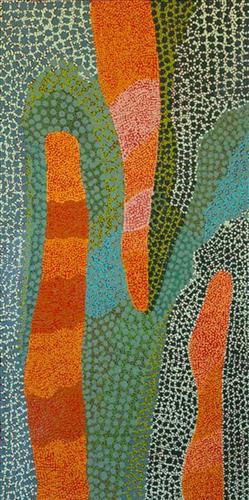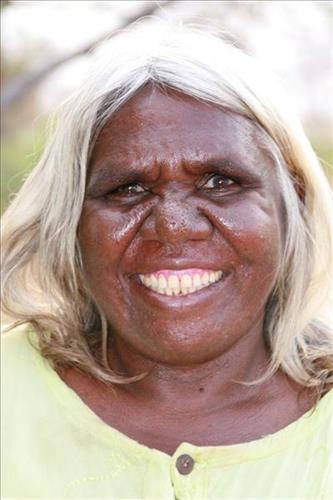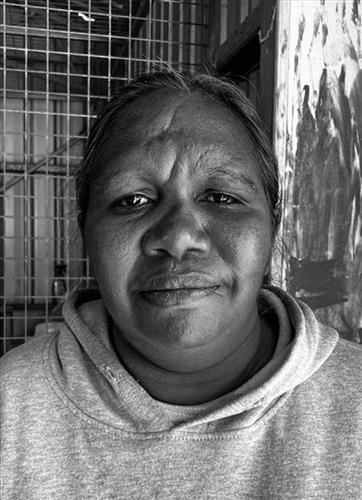111582378399
Kulyakartu
“Kulyakartu, with the sand dunes and the plants, the grass. The season is cold time, after rain, after the rain when it gets green and the different types of grass grow. We are painting about Kulyakartu, I am painting with nana (Nola), the landscape and the colours after the rain. There’s alot of the different plants, especially that one type of grass called yuwinyji that you grind. You take the seed of the grass for the damper.”
– Jenny Butt
“This grass, you take and you do it with the rock, you grind it. You make the seed drop and you clean it up and grind it, you shake it and you make damper. We lived on that, with our families. My nana and my mum, they used to collect that, and then they get the rock, do it on the floor, hard one like this. Tastes nice, Juri (beautiful), they make it into damper. Its nice, soft one. They used to go out and get it, my Nana used to do it, and my mum, while my dad goes out hunting, nyarru.”
– Nola Taylor
Kulyakartu is a large area in the far north of the Martu homelands, near the Percival Lakes region of Western Australia’s Great Sandy Desert. Kulyakartu is mostly flat grass Country, and is known as a good hunting area.
The traditional lands of the Martu people encompass the Great Sandy Desert and Rudall River regions of Western Australia, an enormous tract dominated by distinctive red tali, or tuwa (sandhills). These sandhills present an unforgiving landscape; sparse vegetation covers a seemingly never ending expanse of dunes, and yet these lands and the location of resources within them was known intimately by its pujiman (traditional, desert dwelling) inhabitants.
Depicted in this work are traditional types of edible seeds that were gathered during the pujiman (traditional, desert dwelling) period. At this time Martu would traverse very large distances annually in small family groups, moving seasonally from water source to water source, and hunting and gathering bush tucker as they went. Whilst desert life has moved away from mobile hunter-gatherer subsistence throughout the course of the twentieth century, bush tucker continues to be a significant component of the modern Martu diet. Hunting and gathering bush tucker remains equally valuable as an important cultural practice that is passed on intergenerationally.
Popular plants from which seeds can be harvested include kalaru (samphire, salt bush), yuwinyji and marnkalpa (spinifex species). jiwa were grinding stones for grinding seeds into flour.





